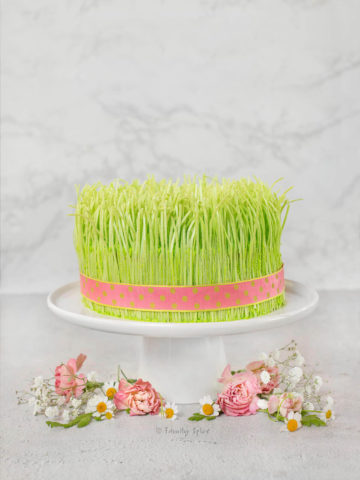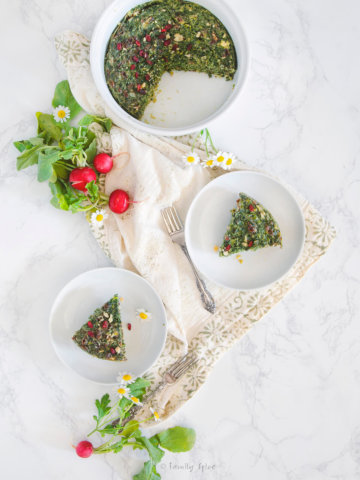Sabzi Pollo (Persian Herbed Rice ) is a truly symbolic dish to celebrate the first day of spring, the first day of the Persian New Year (Nowruz).

The first day of Spring has even more significance in my family, as it represents the first day of the Iranian New Year (read more about Nowruz here). We have many traditions while celebrating nowruz, including spring cleaning and setting up the symbolic sofreh haft seen.
We are supposed to ring in the new year in new clothes. Darn, I really do have to go shopping for new clothes! I have already bought my daughter’s new outfit for that day, that’s the easy part. I will have to find some new shirts for the boys this week.
Why this recipe is so delicious
We don’t break out the champagne like we do in the U.S. or stay up for the countdown to midnight to celebrate nowruz. Every year the new year begins at a different time, because Persians follow the lunar calendar.
Sometimes we “ring in the new year” in the morning, other times it can fall in the middle of the night. We usually celebrate with our extended families, sharing this very traditional dinner together.
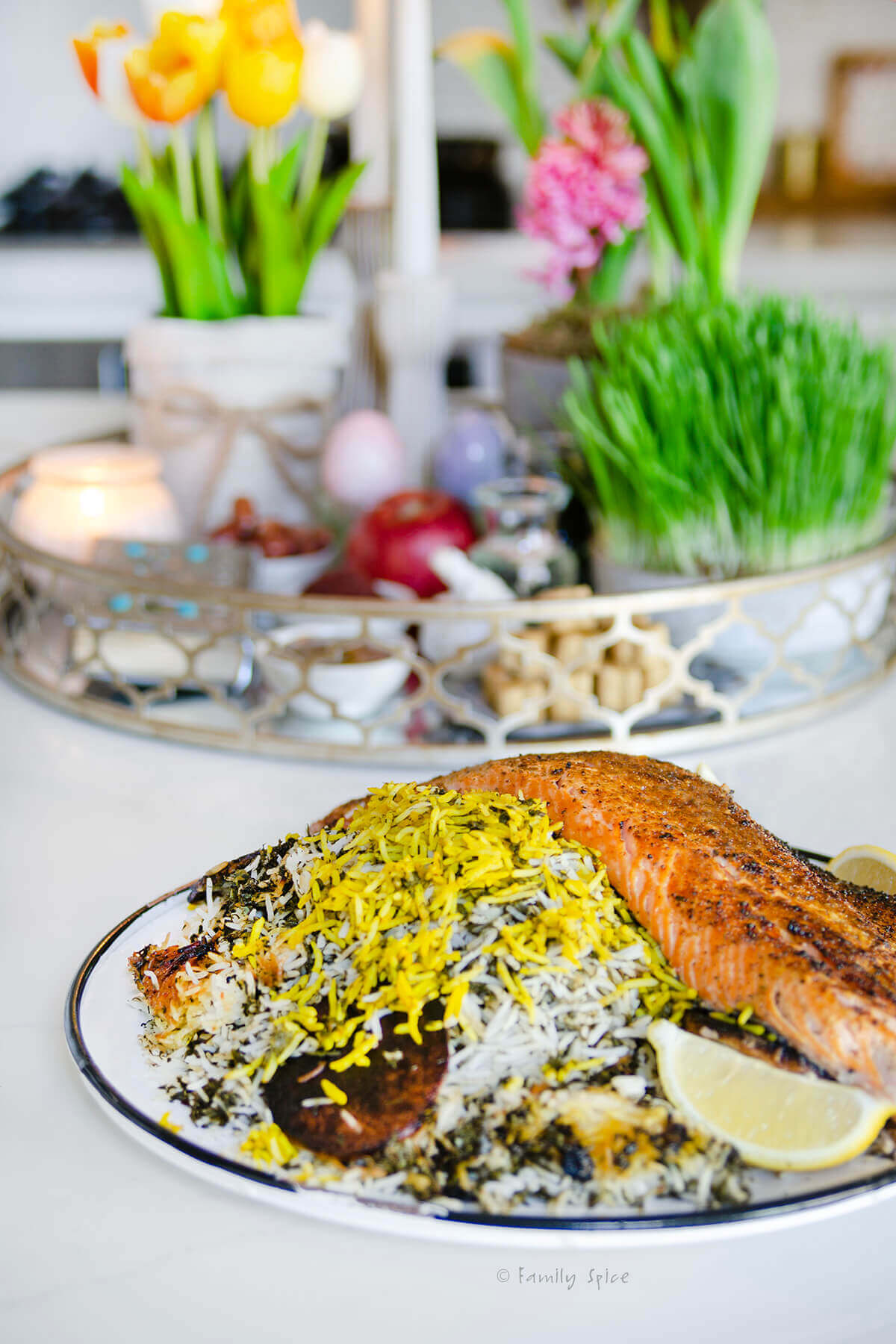
The one meal that you MUST eat to celebrate Nowruz is this Persian Herbed Rice (Sabzi Polo). The fresh herbs used in this dish represent rebirth, as everything that died in the winter is alive again for the spring. Herbs and fresh greens appear all over the nowruz menu.
Fish is usually served with sabzi pollo. Like in many cultures, the fish is a symbol for good luck in the coming year. My mother-in-law usually fries whole white fish, but I am partial to baking a salmon in the oven. Either way, this fragrant dish can be enjoyed all year long.
Ingredients you need
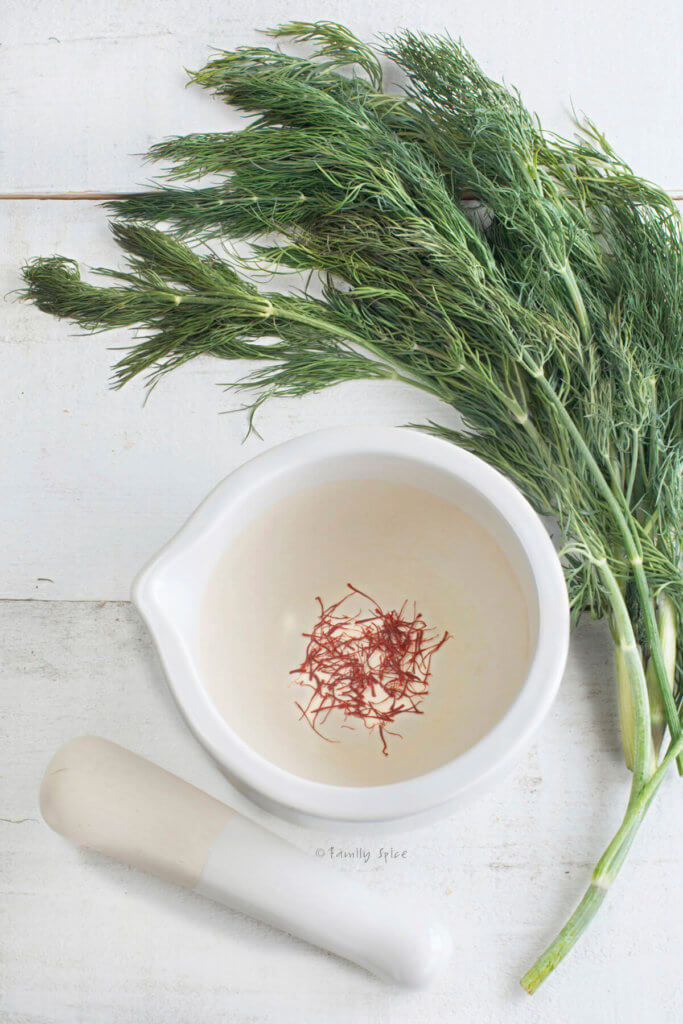
This post contains some affiliate links for your convenience (which means if you make a purchase after clicking a link I will earn a small commission but it won’t cost you a penny more)! Read my full disclosure policy
My herb combination of choice for sabzi polo is dill, parsley, cilantro and green onions. The quantity of the herbs used is also based on preference. I have had sabzi polo where you don’t see one grain of white rice.
My kids won’t eat that. They like it to see some white rice, so I’ve toned down the herbs a little to our family’s taste. So, you decided for yourself which you prefer.
- Basmati rice: Persian rice is made with long brain basmati rice. The brands I use are typically the Indian basmati rice. Some brands I like to cook with include are Royal, Pari and Zaffaroni.
- Saffron: The saffron is crushed in a mortar and pestle and then steeped in hot water. It is then added to rice, to give you that golden rice garnishing for your dish. Choose a high quality saffron, long crimson strands.
- Fresh herbs: As I mentioned before, the variety of herbs used in sabzi pollo varies from person to person. This recipe uses fresh dill, parsley, cilantro, green onions. You can use dried herbs, but it will not taste the same as fresh.
- Extra virgin olive oil: Oil is used on the bottom of the pot to create the crust, or tahdig. I use olive oil, but you can also use any neutral vegetable oil.
- Potatoes: My family loves the crunchy potato tahdig I make with my rice. I prefer to use russet potatoes for tahdig, but you could also use white or red potatoes.

Tools to Use
Step-by-step directions
1. Clean the rice. In some parts of the world you have to remove the pebbles and debris in the rice. Here in the US, this is not necessary. But we rinse the rice to remove the starch. I usually rinse the rice and drain it three times.
2. Soak the rice. How long you soak the rice after rinsing is up to you and how much starch you want in your rice. Some people soak the rice overnight. I only soak it after rinsing it and let it sit while I boil my pot of water.
3. Prepare the herbs. This can take awhile! I typically place the herbs in my sink filled with water and begin the process of picking out the rotting or yellow leaves. I snip off the thick woody stems and place the cleaned greens in a salad spinner to remove the water. Once the herbs are dry, you need to chop them by hand or in a food processor.
Some people like to sauté the herbs before adding them to the rice, but I do not. I prefer to mix the fresh, chopped herbs to steam with the rice.
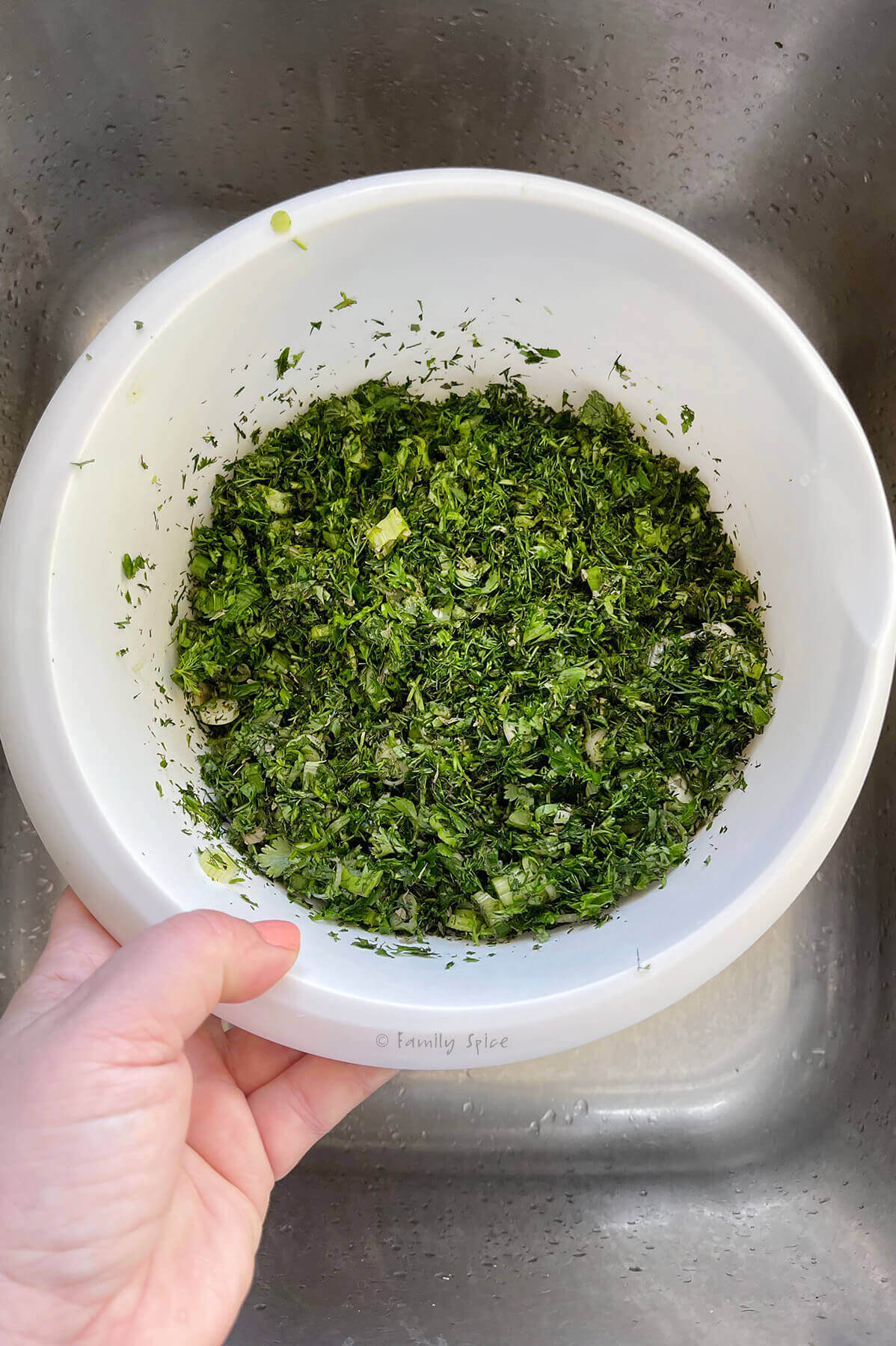
4. Parboil the rice. Fill a large nonstick pot with water and add salt. Bring water to boil. Drain your rice and then add it to the boiling water. Boil it for 6 minutes, or until the outer part of the rice is cooked but the inside is still hard. I live at sea level and 6 minutes is the time it takes for my rice to reach this state. You do not want to over cook the rice. When it reaches this stage, pour the contents of the pot thru a fine mesh strainer to drain out the water.
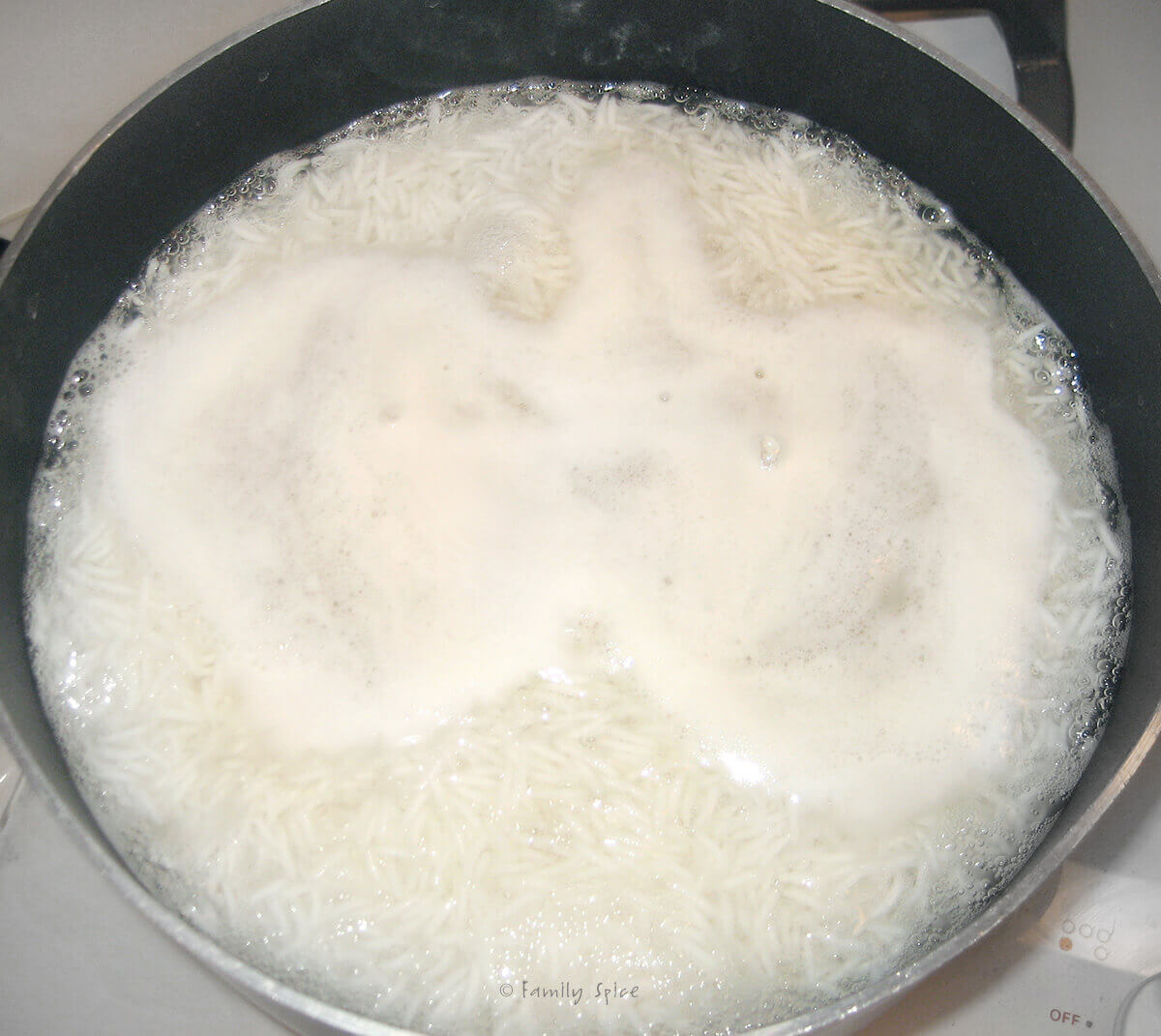
5. Bloo, the saffron. I mentioned above the two different ways you can use the saffron you steep. I typically grab a bit of hot water boiling in the pot before I add the rice and use that to steep the ground saffron. You can pour this saffron liquid over the rice before you place the lid over it and steam it. Or you can steam the rice, remove a scoop of cooked rice, place it in a bowl, mix it with the saffron liquid and use this yellow rice to place on top of the white rice. I like to grind my saffron in a mortar and pestle then add hot water to steep.
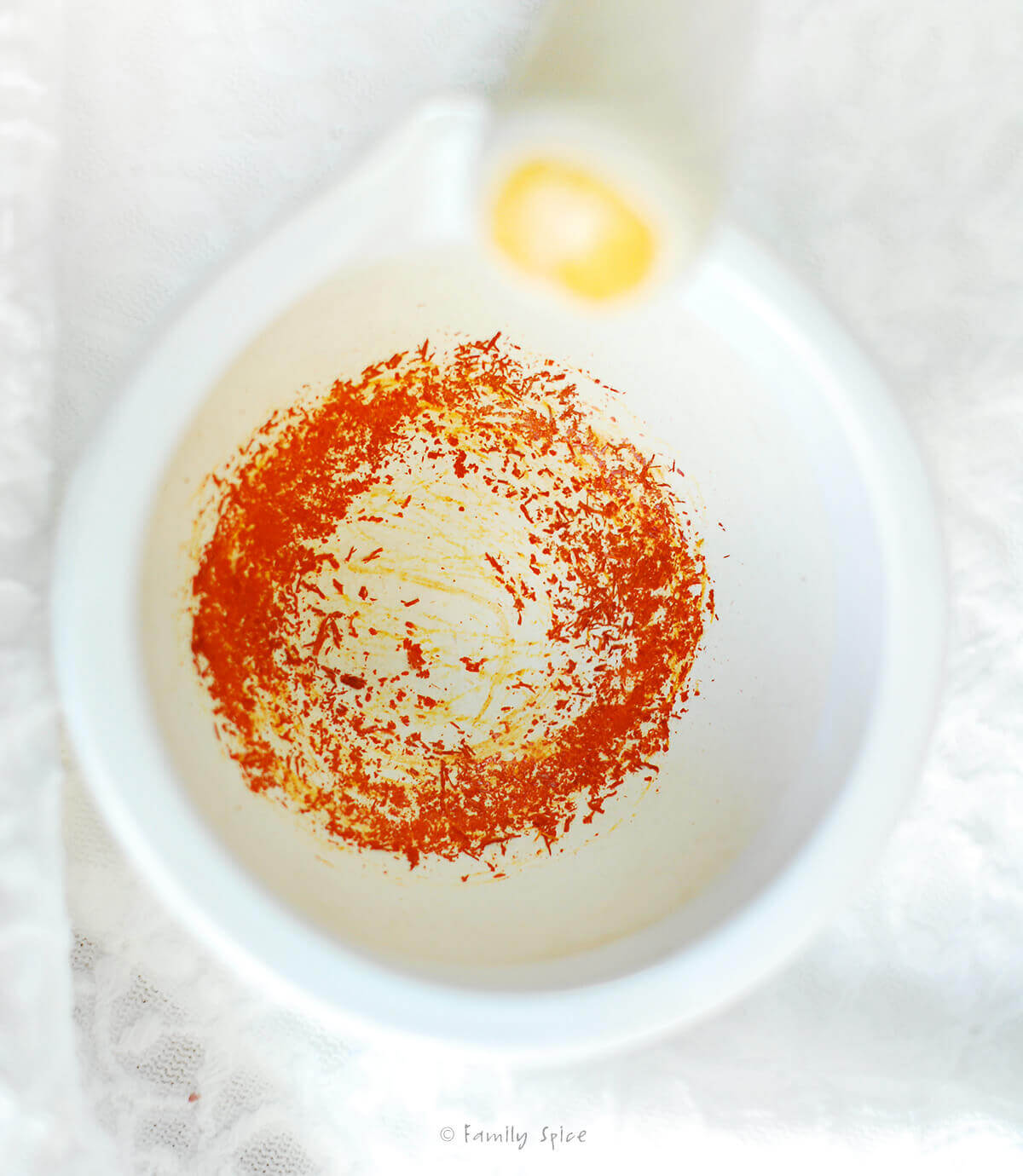
I still have saffron my family has brought for me from Iran, but I still ordered this saffron to try it out. The saffron threads are crimson red, its smells amazing and it produces a bright yellow color to your foods.
6. Prepare the potato tahdig. Return the pot to the stove, turn heat on to medium and coat the bottom of the pot with oil. Add the slices of potatoes in any pattern you like. Season the potatoes with salt.
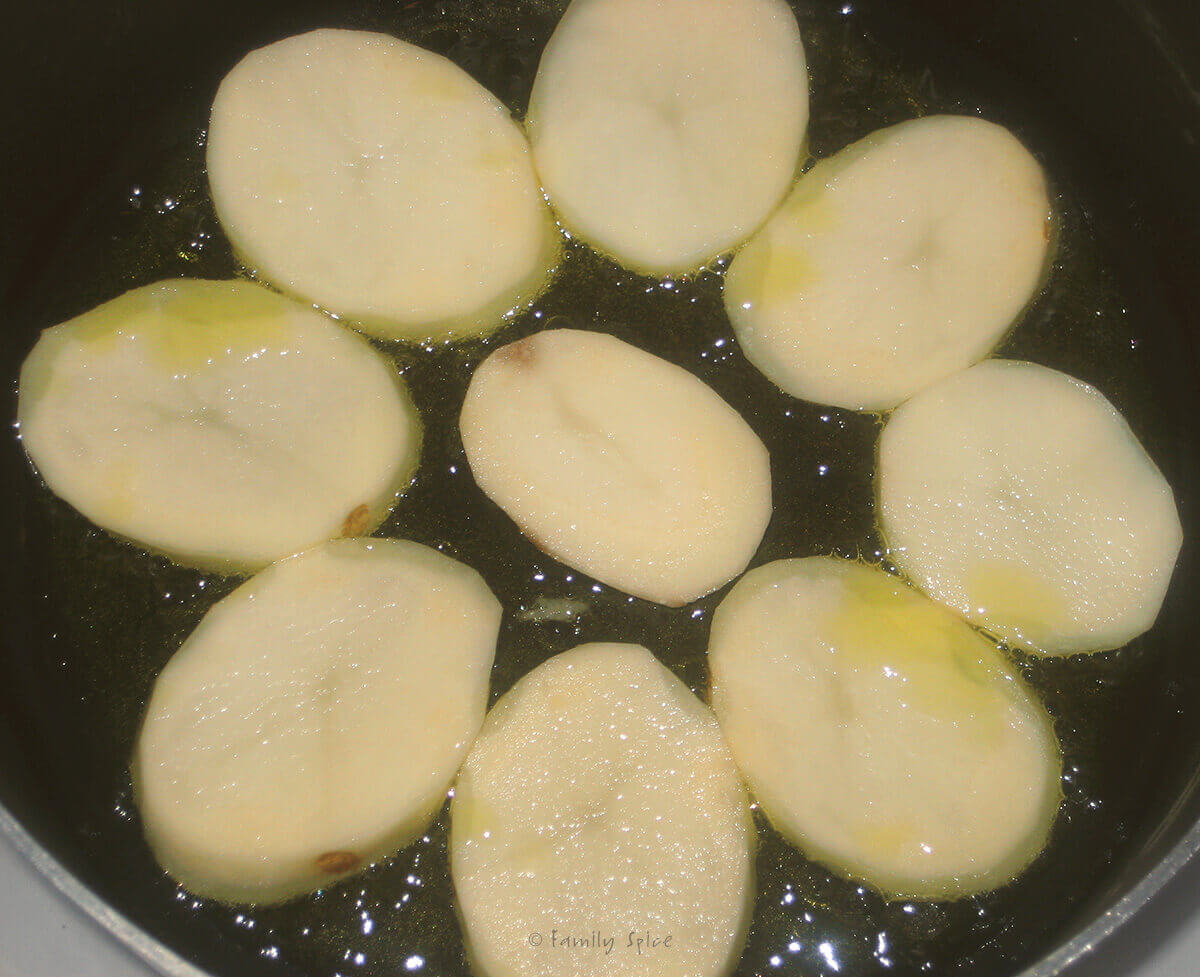
7. Assemble the rice. Using a spatula, gently scoop drained rice from the colander and scatter throughout the pot, over the potatoes, forming one layer. Make sure you do not push the rice in together as this will result in mushy rice. Over the scattered rice use a spatula to scatter a spatula-full of herb-mixture forming another layer. Continue alternating layers of white rice and herbs, until finished. Your pot should not be filled to the very top as you need 3 inches of empty space for the steam.
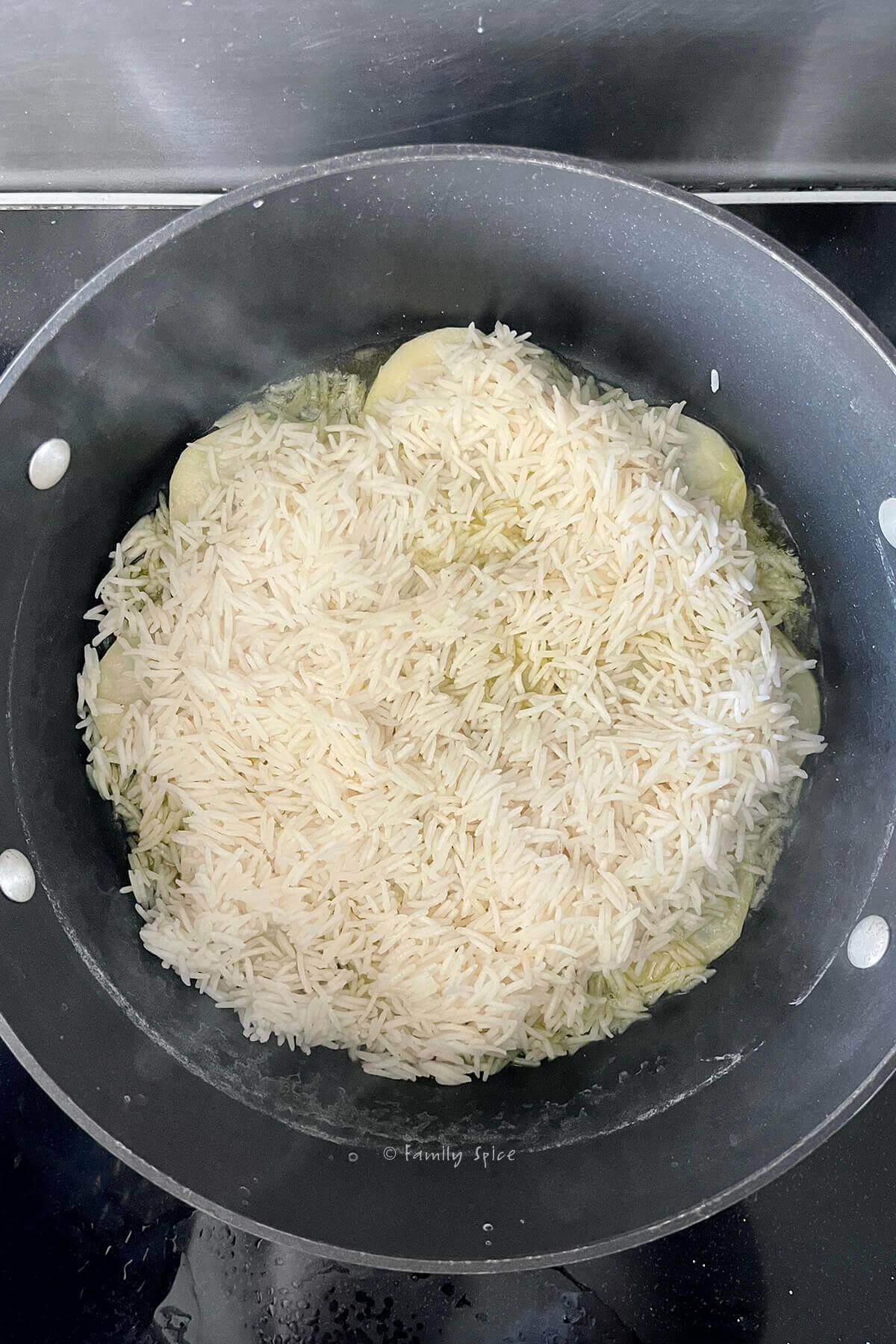
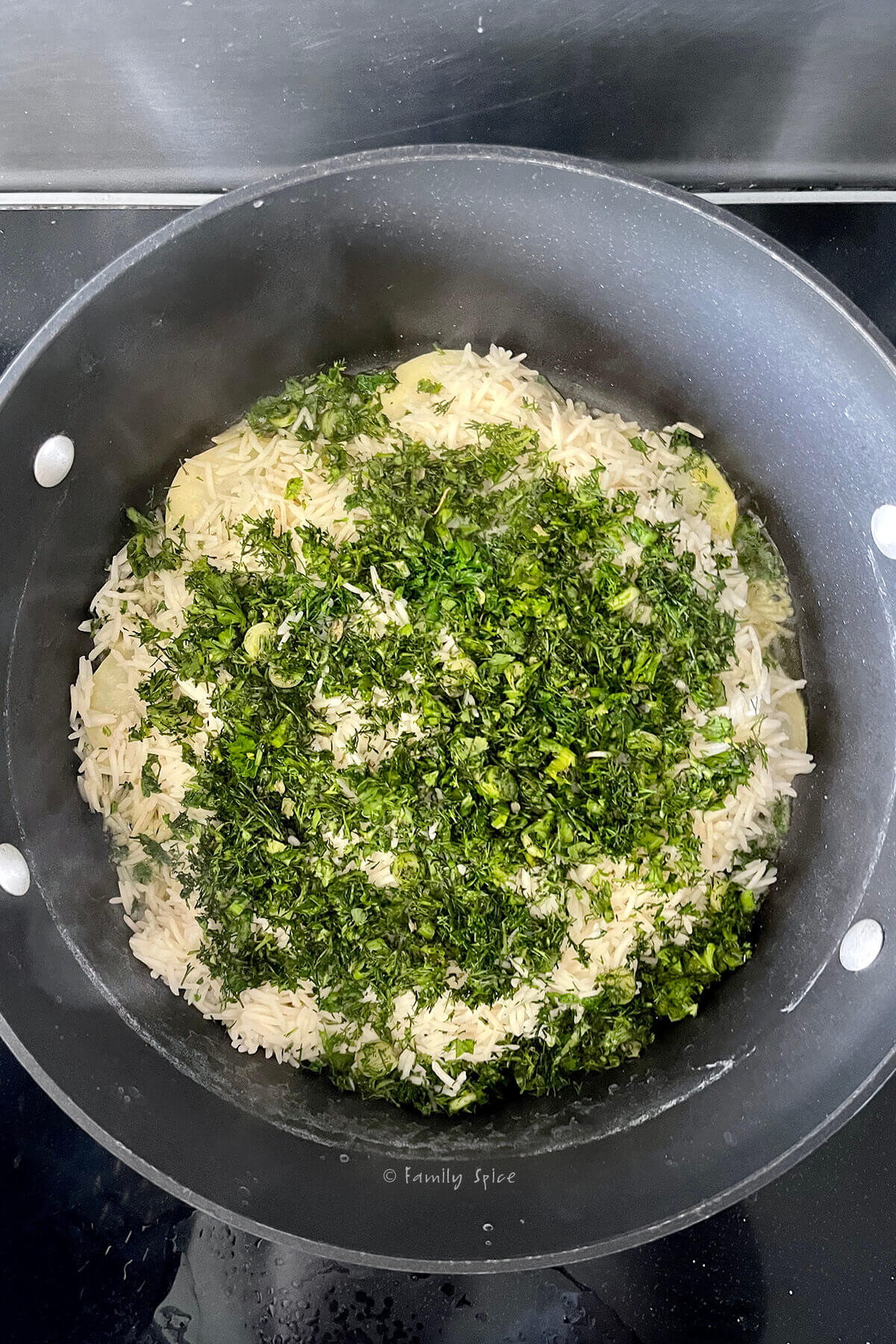
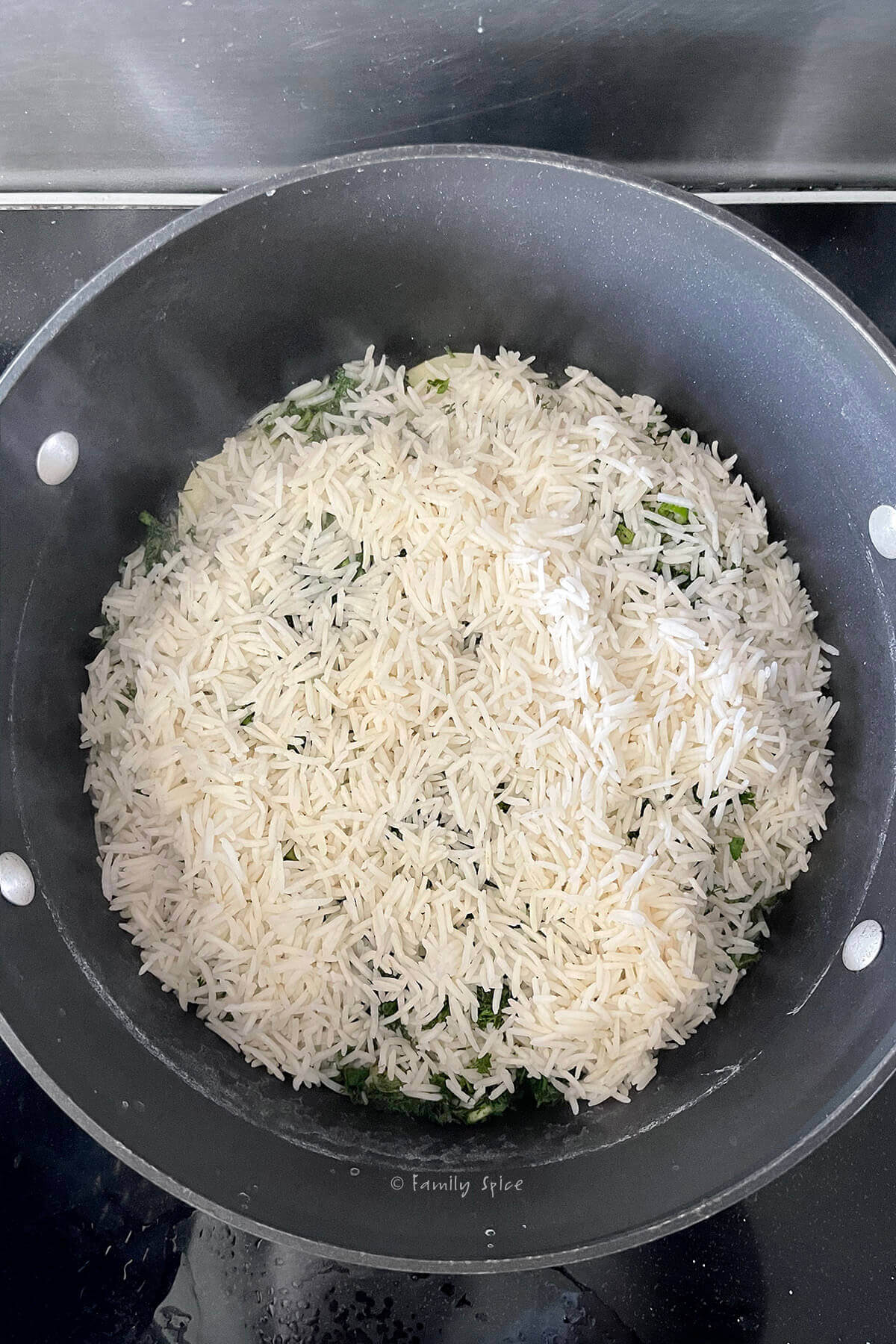
8. Steam the rice. Using the handle of a wooden spoon or other utensil, gently press it thru the rice to create a steam vent. Cover the lid of the pot with a towel and gently press it over the pot. The towel will collect the excess steam and keep your rice from getting mushy. Reduce heat to low and cook for 45 minutes.

9. Serving the rice. There are several ways you can serve your sabzi pollo. When the rice is done, you can place a serving platter on top of the pot, then carefully flip it over. This allows the crispy crust cooking on the bottom of the pot to be presented on top. This can be unnerving to do and sometimes the tahdig sticks. I like to scatter the cooked rice on a serving platter and then scatter the crispy crust pieces around the rice.
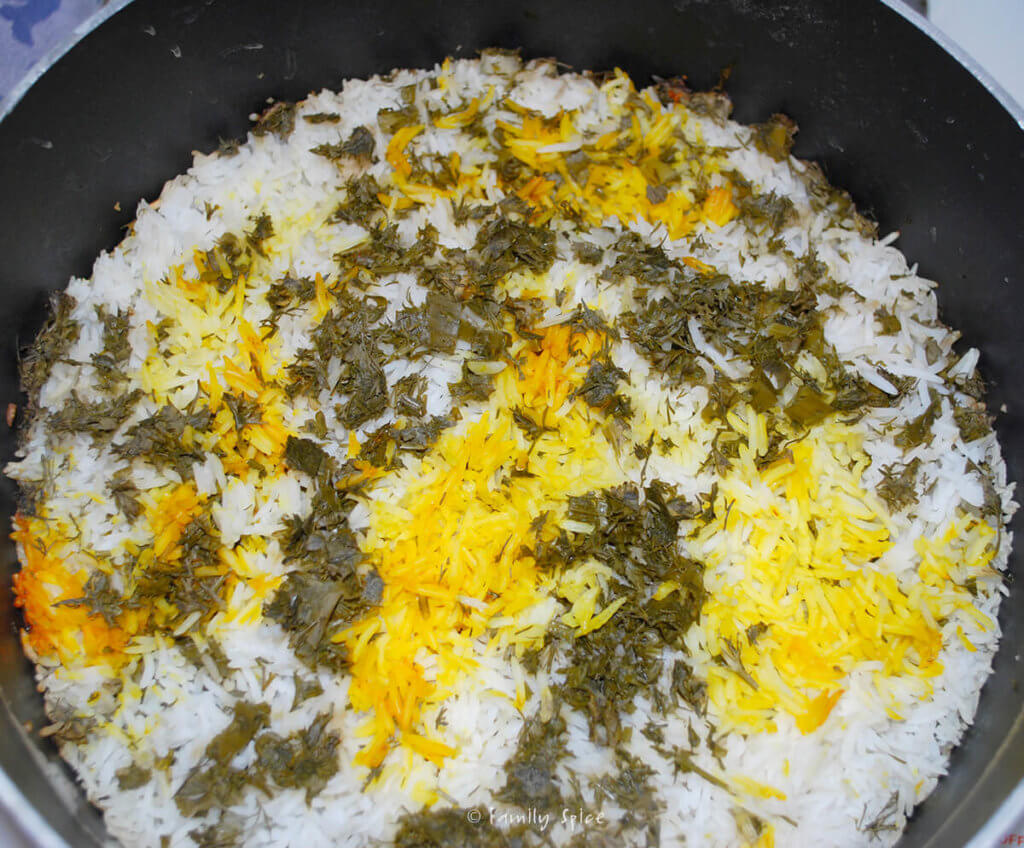
Recipe tips and FAQs
Spring also means that sour oranges (narenj) are in season. Here in the US, these are also known as ornamental oranges. They look like bumpy oranges with thick skin are not sweet, but a type of sour. The flavor is a cross between an orange and lemon.
Narenj’s make a great alternative to fresh lemons or limes. If you are serving fish or chicken with your sabzi pollow, serve with some narenj. Check your local middle-eastern markets from January through spring for this jewel of a find.

My favorite way to serve fish is broiling salmon in the oven. I take a whole salmon and season it with my dry rub chicken seasoning. Then broil it for 15-20 minutes, depending on the size of the salmon and how close you are to the broiler.
So easy and so delicious!
We love to serve this dish with some Persian cucumber salad (Shirazi salad), yogurt with cucumbers (mast o khiar), a platter of fresh herbs (sabzi khordan), and/or Persian pickled vegetables (torshi bademjan).
And if you are serving this for your nowruz dinner, be sure to make kookoo sabzi (Persian herb quiche) and ash reshteh (Persian bean and noodle soup).
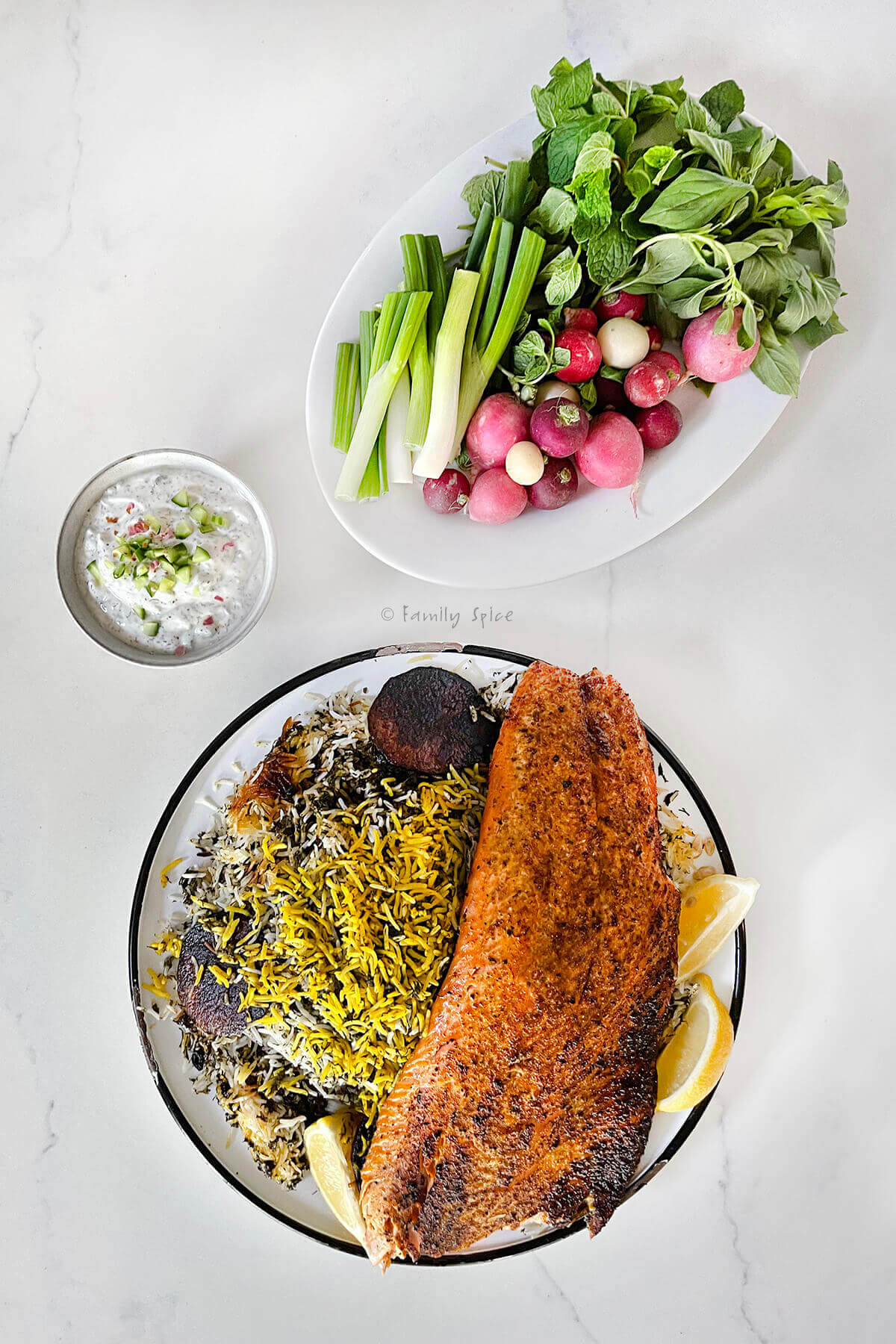
Be sure to use plenty of oil for the bottom of the pot for your tahdig. If the crust won’t come out of the pot, stick the bottom of the pot in a sink filled with a couple inches of cold water. This will help the crust release. If your crust isn’t crispy enough, increase the heat and let the crust crisp up a few minutes before removing.
What do you eat with Sabzi Polo?
Sabzi polo is an herb filled rice dish made to celebrate the first day of spring, the Persian New Year (nowruz). It is typically served with fish, which is thought to bring good luck. Other dishes served include kookoo sabzi (Persian herb quiche) and ash reshteh (Persian noodle soup). You can also serve it with Shirzai Salad (tomato and cucumber salad) and Mast o Khiar (yogurt with cucucmbers).
Sabzi are herbs and greens Persians like to eat. Persian food is filled with many uses for fresh herbs. We also like to serve a platter of fresh herbs with our meals. It is very aromatic and delicious. Sabzi and foods made with greens is also served specifically to commemorate the first day of spring, the Persian new year (nowruz). The greens symbolize the rebirth found during springtime.
If you want to learn more about Nowruz, I have written an ebook that has everything you need to celebrate Nowruz. You can learn more about my Nowruz ebook here.

Persian Herb Rice (Sabzi Pollo)

Sabzi Pollo (Persian Herbed Rice ) is a truly symbolic dish to celebrate the first day of spring, the first day of the Persian New Year (Nowruz).
Ingredients
- 3 cup basmati rice
- 16 cup water
- ¾ teaspoon salt
- 1 TBS hot water
- ½ teaspoon saffron, crushed
- 1 ½ cup chopped fresh dill
- 1 cup chopped fresh parsley
- ½ cup chopped green onions
- ¾ cup chopped fresh cilantro
- 3 TBS extra virgin olive oil, divided
- 8 oz russet potatoes, peeled and sliced into ¼-inch rounds
Instructions
- In a medium-sized bowl cover rice with water. Gently wash rice by stirring it in the water with your hand. This helps wash the starch and grit out. Pour out water and repeat two more times.
- After washing rice a third time, let it soak in water.
- In a small bowl combine hot water and crushed saffron. Let saffron steep for 10 minutes before using.
- In another bowl combine chopped herbs and reserve.
- Bring 8 cups water with ½ teaspoon salt to boil in a 5-quart non-stick pot.
- When water in pot has come to boil, drain the rice. Add the drained rice to the boiling water.
- When the water returns to a boil and the rice floats to the top (approximately 6 mins), strain the contents of the pot through a fine colander. You know your rice is ready to strain if you bite a rice kernel and the center is uncooked.
- Return pot to burner, set heat to medium and add olive oil.
- Line the bottom of the pot in one layer with potato rounds.
- Sprinkle ¼ teaspoon salt over the potato rounds.
- Using a spatula, gently scoop drained rice from the colander and scatter throughout the pot, over the potatoes, forming one layer. Make sure you do not push the rice in together as this will result in mushy rice.
- Over the scattered rice use a spatula to scatter a spatula-full of herb-mixture forming another layer.
- Continue alternating layers of white rice and herbs, until finished. Your pot should not be filled to the very top as you need 3 inches of empty space for the steam.
- Pour the saffron mixture over the top of rice. Then pour 1 TBS olive oil over the top of the rice, as well.
- Cover the lid of your pot with a clean towel or several paper towels, and set firmly over your pot to prevent steam from escaping. The towel will keep the condensation from dropping back into your rice and turning the rice into mush.
- After 10 minutes, lower heat to low and let rice finish cooking for another 45 minutes.
- Using a spatula, gently scoop rice out and onto serving platter. On the bottom you will find the crust (called "ta-dig"). Place the crust pieces along the platter.
- If the crust won't come out of the pot, stick the bottom of the pot in a sink filled with a couple inches of cold water. This will help the crust release.
Notes
The quantity and variety of herbs used in Sabzi Polo varies with who is making it. Some people like the rice to be practically green and filled with herbs while others prefer less. So use these measurements as a guideline and don't stress over measuring everything exactly.
Nutrition Information:
Yield:
8Serving Size:
1-2 cups riceAmount Per Serving: Calories: 155Total Fat: 5gSaturated Fat: 1gTrans Fat: 0gUnsaturated Fat: 4gCholesterol: 0mgSodium: 394mgCarbohydrates: 24gFiber: 1gSugar: 1gProtein: 3g
PS If you try this recipe, why not leave a star rating in the recipe card right below and/or a review in the comment section further down the page? I always appreciate your feedback.
You can also follow me on Pinterest, Facebook or Instagram. Sign up for my eMail list, too!


